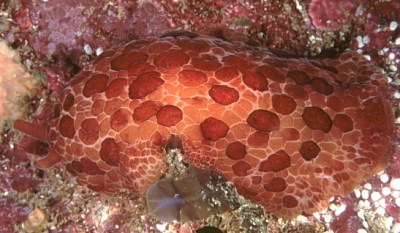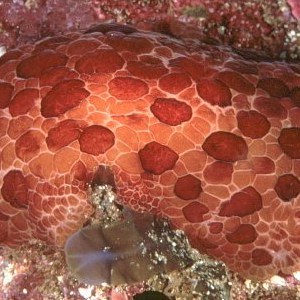Re: Pleurobranchus from southern California
January 23, 2001
From: Dave Behrens


Dear Bill:
This is a critter I have been wrestling with for about 3 years, when it first showed up in the California Channel Islands after El Nino, here. I have received almost a dozen inquiries about its identity from interested Branchers. I have attached a photo of one from San Benitos Island, outer coast of Baja California, Mexico, August 1996. Photo: Eric Haucke of Santa Cruz, California. It was the Week 71 opisthobranch on Mike Miller's Site
Its identification has caused some discussion among our California colleagues. I seem to be odd man out, however. At this time we agree with your ID. Internally the critter is identical to Pleurobranchus areolatus. The major difference and the one that bothers me is the texture and lack of white flecks on the dorsal tubercles.
You might notice that in Briannes's photos and in Eric Haucke's, the tubercles are very low, flat and absolutely smooth, not a white fleck to be found. In typical P. areolatus the tubercles vary in height and have a central point (not easily seen in Phanor's photos), and always are covered with white flecks and encrustations.
In any event, just last week Terry Gosliner told me that we soon will have the answer. One of his student's has received a grant to look at genetic similarities/differences of species living on both sides of the Panama Isthmus. Pleurobranchus areolatus is to be included in this effort. We have
collected typical Pleurobranchus areolatus material from the Caribbean and Pacific side, and have tissue from the animal Brianne shares here. The three will be compared. I am looking forward to the results.
Dave Behrens
Dave@seachallengers.com
Behrens, D. , 2001 (Jan 23) Re: Pleurobranchus from southern California. [Message in] Sea Slug Forum. Australian Museum, Sydney. Available from http://www.seaslugforum.net/find/3596Dear Dave,
I think the problem may be more complicated than it appears on the surface. As I mentioned when discussing Phanor's message there seems to be a problem in determining just what is "typical' P. areolatus. The original description didn't give too many clues. Phanor also sent photos of a second species from the Caribbean coast which look to be very like the Indo-West Pacific Pleurobranchus albiguttatus. Are its white markings what you are suggesting is typical of Caribbean P. areolatus? This is the species Humann identifies as P. areolatus.
In brief there seem to be three obvious questions. Firstly how many species of Pleurobranchus occur in the Caribbean? Secondly, if there is more than one, which is P. areolatus? And thirdly, do any of them, also occur on the Pacific side of the isthmus?
Cheers,
Bill Rudman
Related messages
-
Giant Pleurobranchus areolatus from Cabo Frio, Brazil.
From: Vinicius Padula, February 15, 2005 -
Re: Pleurobranchus areolatus from Brazil
From: Fabio Wiggers, January 25, 2004 -
Pleurobranchus areolatus from Jamaica
From: Ross W. Gundersen, October 20, 2003 -
Re: Pleurobranchus areolatus from Brazil
From: Vinicius Anderson, September 12, 2003 -
Brazilian Pleurobranchus areolatus?
From: Vinicius Anderson, September 10, 2003 -
Pleurobranchus species question
From: Alicia Hermosillo, September 20, 2002 -
Pleurobranchus? from Colombia
From: Elianny Dominguez Tejo, September 16, 2001 -
Pleurobranchus from southern California
From: Brianne Berlin, January 20, 2001 -
Notaspids from Colombia
From: Phanor Montoya, October 22, 2000
